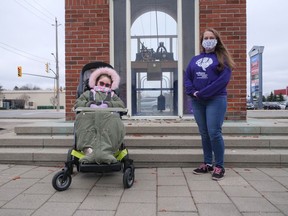Sinclair-Reece raises awareness for epilepsy

Article content
Tillsonburg’s Elizabeth Sinclair-Reece is still trying to figure out what works best for controlling her seizures.
Sinclair-Reece, who turns 41 in April, has had epilepsy for two years.
“Most of the time, they never actually find a reason,” she said.
“It’s unknown,” said Tillsonburg’s Teresa Hartford, who has a daughter with epilepsy. “With her (Hollie), they were checking both sides of the family, our genetic doctor was going back both lines and they couldn’t figure it out. They were doing blood work, they were doing anything and everything they could to figure out why.”
“For me, I found out when I was 39 that I have epilepsy,” said Sinclair-Reece. “Mine are nocturnal, so I only have them (seizures) in my sleep. I also just found out that I have sleep apnea, and I stop breathing 20 times an hour in my sleep. So that could actually be triggering the seizures, but I don’t know. I have a couple other problems too and I don’t know where they start and where they end.”
Sinclair-Reece just found out Friday that her medication has been “too high.”
“It’s been one heck of a ride… and I have no idea, I have no answers. And so far they have no answers yet either.”
The Mayo Clinic defines epilepsy as a central nervous system (neurological) disorder in which brain activity becomes abnormal, causing seizures or periods of unusual behaviour, sensations, and sometimes loss of awareness.
A mother and wife, Sinclair-Reece said epilepsy has affected her life, especially in the last few weeks.
“When I have a seizure it changes the way I think and the way I feel. When I have a seizure I just feel a little different. It’s like every time I have one, I’m on to another level.”
After having a seizure, Sinclair-Reece typically wakes up in an ambulance.
“My seizures are very severe, one of the worst that you can have, so I go very unconscious. The last one I had – the beginning of February – I was in a sleep study. So they were watching me, listening to me.”

Sinclair-Reece’s seizures typically happen about 30 minutes before she wakes up, and she was half-conscious the last time.
“I heard myself making noises. Then I could see this side of the wall, that side of the wall, back and forth a couple times. Next thing I knew, the ambulance was there.
“It can be pretty scary. Especially when the person is unconscious, you don’t know what to do. Most people, they think they’re supposed to hold them or put something in their mouth so they don’t choke and that’s exactly what you’re not supposed to do…”
“Please don’t!” Hartford agreed. “Please don’t ever do that.”
Sinclair-Reece’s first seizures were one year apart. Then six months apart. Then three months.
“I tend to have them in groups, so I tend to have a couple at a time when I have them.”
“It’s almost traumatizing,” said Jeff Reece. “We’ve been living together 20-years-plus, and this has just happened in the last couple of years.
“So I wake up to that,” said Reece. “To see that happening, it’s a traumatizing image that’s hard to get out of your head. That’s the toughest part.”
“But it is so comforting … normally he’s with me every time I have one,” Sinclair-Reece said.
There is currently no cure for epilepsy, said Sinclair-Reece.
“There’s barely any funding to help find a cure,” said Hartford.
“It’s not talked about very often,” said Sinclair-Reece. “But talking about it, it’s surprising how many people have it.”
As for the future, Sinclair-Reece said she will continue trying her medications.
“I think that eventually we will find a med, hopefully, so that my seizures do stop or become less often. For me, personally, I just find positive things, like doing something like this…”
Sinclair-Reece had approached Tillsonburg town council at its March 22 virtual meeting and requested that the Rotary Clock Tower be lit purple on Friday, March 26 in honour of Epilepsy Awareness Day.
“There’s so much negative, so much stress, it’s so hard,” said Sinclair-Reece. “So when you can do something positive, for me it just fills my bucket.”
“Someone who understands me,” Hartford nodded. “I don’t want people to be scared when they see one.”
Sinclair-Reece said she plans to be licenced for seizure first aid.
“If I’m meeting people who have epilepsy, I’m talking to people, I’m informing people, for me that is what is going to help me move forward.”
Postmedia is committed to maintaining a lively but civil forum for discussion. Please keep comments relevant and respectful. Comments may take up to an hour to appear on the site. You will receive an email if there is a reply to your comment, an update to a thread you follow or if a user you follow comments. Visit our Community Guidelines for more information.